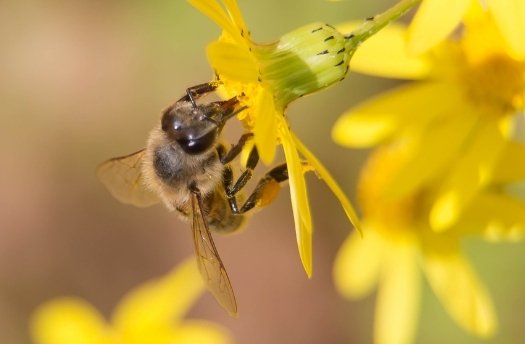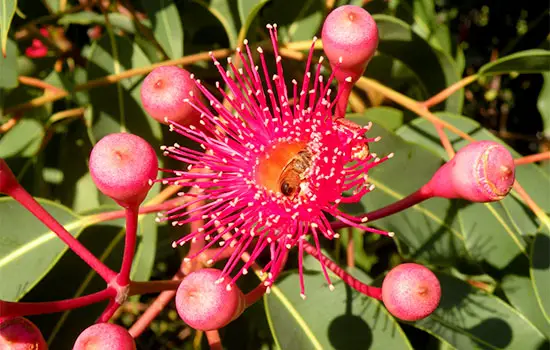Bees collect nectar because it is an essential food source for the colony. Nectar provides the carbohydrates needed for bees to perform daily tasks such as flying and colony maintenance.

What Do Bees Do With Nectar?
Foraging bees extract nectar from flowers and store it in their special honey stomach, known as a crop, to be transported back to the hive.
When hungry, a bee will open a valve and a portion of the nectar will pass from her honey crop through to her own stomach to be converted to energy for her own needs.
Bees feed each other nectar using a method called trophallaxis, where the nectar is regurgitated by one bee and fed to the next one.
Do Bees Eat Nectar?
Bees certainly do eat nectar. They utilize the nectar they collect, and the honey they make from it, as their energy source. The nectar contains carbohydrates and various minerals such as calcium, sodium, magnesium, copper and potassium.
The presence and concentration of these minerals varies from one source of flora to another. Factors that affect the availability of these minerals include the weather, the amount of water available and the type of soil in which the plant lives.
How do bees store nectar?
Forager bee remove nectar from flowers using their proboscis. They store collected nectar in a special internal honey stomach, or crop. The forager bees begin to break down the sugars in the nectar by adding enzymes.
When the honey crop is full, forager bees carry the nectar back to the hive where it is transferred to specialized worker bees.
These bees continue the process of changing the chemical composition of the nectar by adding enzymes. This process is called trophallaxis and involves the foragers regurgitating the nectar which is then taken up by the workers.
Nectar is watery, so moisture needs to be removed before it can be stored as honey.
The evaporation process begins when the forager bees transfer their nectar load to the worker bees, who in turn expose a small amount of the nectar to the warm air of the hive. This process continues for about twenty minutes until the partially ripened honey is stored in a cell.
The circulating warm air in the hive continues the evaporation process. When the moisture content reaches between 14 to 18% the ripened honey is capped. The beeswax capping protects the honey from becoming contaminated.
Nectar can be temporarily left in other areas of the hive where conditions favor evaporation. It may be deposited in cells that surround the brood nest or a droplet may be seen on the roof of a cell that contains eggs or small bee larvae.
The partially ready nectar is later collected and stored in cells as honey. Honey can be stored in cells that surround the brood in the central frames. The outer frames usually contain capped honey exclusively.
The stored honey is essential food for the colony in the winter months when the weather makes foraging less likely. It gives the colony the energy it needs to help maintain the desired temperature of the winter cluster.
How Do Bees Get Nectar From Flowers?
Forager bees get nectar from flowers using their proboscis, or mouth parts. They suck the nectar into their honey stomach, or crop. Foragers are the oldest bees in the colony, having performed all the other tasks needed to maintain the survival of the colony.
Foraging bees have a hardened exoskeleton and well-developed flight muscles to equip them for the arduous task of flying back and forth to the hive, collecting and depositing nectar and pollen.
Nectar is produced by nectaries, which are special glands usually found in the deepest part of the flower. To access the nectaries, the forager will brush past the pollen-laden anther or male part of the flower. Using their proboscis, the bees will suck up the nectar into their honey stomach or crop.
Once their crop is full, they return to the hive to pass the nectar to the worker bees, who store and evaporate the nectar until it becomes honey.
How Do Bees Know Which Flowers Have Nectar?
Bees use a number of clever methods to find which flowers have nectar:
1. Type Of Flower
Foragers are attracted to simple or single flowers that have an open, cup like face as the nectar and pollen is readily accessible. The proboscis of a European bee is approximately 5.7 to 6.7 millimetres (according to The Australian Beekeeping Manual). So any flower that has its nectar source deeper than this won’t be accessible.
Plants that have a cluster of individual flowers along, or at the end of a stem, are very attractive to foragers – because they save energy by accessing the pollen and nectar from the many flowers along the stem, all during a single foraging trip.

2. Color Of The Flower
Foragers are attracted to the colors purple, blue, violet, yellow and white. They possess the ability to see ultra violet light, which we cannot, so many of the attributes and marks it finds pleasing in a flower aren’t visible to us.
Although bees can’t see the color red, many red flowers have other markings or ultra violet stripes that act as signposts to guide the bee to the nectary.
3. Scent Of The Flower
Bees have poor visual acuity or clarity of sight. Unlike our eyes, bees have compound eyes, which consist of thousands of tiny photo receptors that allow them to focus well up close. Therefore they rely on scent to find flowers at a distance.
4. Electrical Charge Of The Flower
According to research conducted in England, plants emit a weak negative electrical impulse that may signal to bees there is food available.
Bees wings generate a positive impulse as they fly from flower to flower. It’s a well-known scientific fact that opposite charges attract, so it’s possible the negative charge emitted by the plant attracts the bee to it.
A subsequent scientific experiment concluded that bees appear to be sensitive to the negative electrical signal given off by flowers and attracted to this impulse when searching for nectar and pollen.
Researchers have also determined that bees know when the nectar in a flower has been harvested by another insect, because the electrical signals change once the nectar has been removed.
5. The Waggle Dance
When a forager finds a good source of nectar and pollen, she returns to the hive to tell the others. She does this by performing what is known as the waggle dance, which lets the other foragers know the distance and direction of the food source.
In addition, the forager returns to the hive with the smell of newly found nectar and pollen sources on her body. Together with a donated sample of the nectar, the foragers are able to locate the good food source.
Inside the beehive it is usually dark and, with their poor visual acuity, the foragers can’t see the waggle dance. Instead, they follow the performance using their antennae to feel the vibrations produced during the dance. This helps them determine the location of the food source.
How Much Nectar Do Bees Collect In A Day?
Researchers have found bees can carry around 28mg of nectar, equivalent to 40% of their body mass (approx. 70 mg). In some cases, the loads of nectar were nearly the same as their body weight.
However, the amount of nectar collected varies and is dependent upon several factors:
The Season
During the Spring and Summer seasons, when the weather is warm and sunny, more plants and trees flower. This provides greater opportunities for the foragers to collect nectar. The days are longer in the warmer seasons too, so forager bees have more time to collect food.
The Strength Of The Hive
A strong and healthy hive with a large bee population will have more foragers available to collect nectar from flowering plants.
Space In The Hive
Ample room in the hive will allow forager bees to collect and store the surplus nectar.
Nectar-rich Flora
Some flowering plants provide more nectar than others, and some types of nectar are more beneficial to bees than other types. In addition, the amount and nutritional value of nectar gathered will vary from day to day, depending on the health of the flowering plant. If there has been above average rainfall prior to the Spring, then more nectar will be available.
Summing Up…Why Is Nectar Important To Bees?
Nectar is important to bees because it is an essential source of energy, in the form of carbohydrates, for the colony. It allows the bees, including the queen, to perform all the necessary tasks needed for the colony to function and thrive.
As a beekeeper, you should ensure your garden has many different flowering plants and trees to provide your colony with nectar. It’s important to provide your bees with plants that are of the right color and type to allow your foragers to access the nectar easily.
